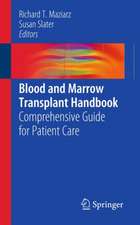Molecular Determinants of Head and Neck Cancer: Current Cancer Research
Editat de Barbara Burtness, Erica A. Golemisen Limba Engleză Hardback – 8 apr 2014
| Toate formatele și edițiile | Preț | Express |
|---|---|---|
| Paperback (2) | 1112.70 lei 43-57 zile | |
| Springer International Publishing – 29 dec 2018 | 1112.70 lei 43-57 zile | |
| Springer – 3 sep 2016 | 1161.57 lei 43-57 zile | |
| Hardback (2) | 974.39 lei 22-36 zile | +49.27 lei 6-12 zile |
| Springer International Publishing – 13 aug 2018 | 974.39 lei 22-36 zile | +49.27 lei 6-12 zile |
| Springer – 8 apr 2014 | 1609.56 lei 22-36 zile |
Din seria Current Cancer Research
- 5%
 Preț: 1132.09 lei
Preț: 1132.09 lei - 5%
 Preț: 728.66 lei
Preț: 728.66 lei - 5%
 Preț: 1421.21 lei
Preț: 1421.21 lei - 5%
 Preț: 1094.08 lei
Preț: 1094.08 lei - 5%
 Preț: 1089.85 lei
Preț: 1089.85 lei - 5%
 Preț: 1481.57 lei
Preț: 1481.57 lei - 5%
 Preț: 1094.80 lei
Preț: 1094.80 lei - 5%
 Preț: 1447.73 lei
Preț: 1447.73 lei - 5%
 Preț: 706.97 lei
Preț: 706.97 lei - 5%
 Preț: 1096.81 lei
Preț: 1096.81 lei - 5%
 Preț: 1098.48 lei
Preț: 1098.48 lei - 5%
 Preț: 1112.17 lei
Preț: 1112.17 lei - 5%
 Preț: 714.63 lei
Preț: 714.63 lei - 5%
 Preț: 1297.22 lei
Preț: 1297.22 lei - 5%
 Preț: 1100.64 lei
Preț: 1100.64 lei - 5%
 Preț: 1103.95 lei
Preț: 1103.95 lei - 5%
 Preț: 715.35 lei
Preț: 715.35 lei - 5%
 Preț: 1171.03 lei
Preț: 1171.03 lei - 5%
 Preț: 902.44 lei
Preț: 902.44 lei - 5%
 Preț: 1608.47 lei
Preț: 1608.47 lei - 5%
 Preț: 1438.78 lei
Preț: 1438.78 lei
Preț: 1609.56 lei
Preț vechi: 1694.27 lei
-5% Nou
Puncte Express: 2414
Preț estimativ în valută:
307.99€ • 322.38$ • 256.34£
307.99€ • 322.38$ • 256.34£
Carte disponibilă
Livrare economică 10-24 martie
Preluare comenzi: 021 569.72.76
Specificații
ISBN-13: 9781461488149
ISBN-10: 1461488141
Pagini: 372
Dimensiuni: 155 x 235 x 27 mm
Greutate: 0.68 kg
Ediția:2014
Editura: Springer
Colecția Springer
Seria Current Cancer Research
Locul publicării:New York, NY, United States
ISBN-10: 1461488141
Pagini: 372
Dimensiuni: 155 x 235 x 27 mm
Greutate: 0.68 kg
Ediția:2014
Editura: Springer
Colecția Springer
Seria Current Cancer Research
Locul publicării:New York, NY, United States
Public țintă
ResearchCuprins
Chapter
1:
Overview:
The
Pathobiology
of
Head
and
Neck
Cancer
Chapter 2: Human papillomavirus (HPV)-positive head and neck cancer and the Wnt signaling pathway…..Theodoros Rampias and Amanda Psyrri
Chapter 3: EGFR Inhibitors as Therapeutic Agents in Head and Neck Cancer…..Hanqing Liu, Jennifer R. Cracchiolo, Tim N. Beck, Ilya G. Serebriiskii, and Erica A. Golemis
Chapter 4: The Role of HGF/c-MET in Head and Neck Squamous Cell Carcinoma…..Tanguy Y. Seiwert, Tim N. Beck and Ravi Salgia
Chapter 5: Insulin-like Growth Factor-1 Receptors in Head and Neck Cancer…..Steven A. Rosenzweig and Casey O. Holmes
Chapter 6: The PI3K Signaling Pathway in Head and Neck Squamous Cell Carcinoma……Jason D. Howard and Christine H. Chung
Chapter 7: Jak/STAT Signaling in HNC…..Bhavana S. Vangara and Jennifer R. Grandis
Chapter 8: TGFβ regulates EMT in head and neck cancer…..Jill M. Neiman and Xiao-Jing Wang
Chapter 9: p53 in Head and Neck Cancer…..Jong-Lyel Roh and Wayne M. Koch
Chapter 10: DNA damage proteins and response to therapy in head and neck cancer…..Ranee Mehra and Ilya G. Serebriiskii
Chapter 11: Hypoxia and radioresistance in head and neck cancer…..Peiwen Kuo and Quynh-Thu Le
Chapter 12: The Wnt -catenin Signaling Circuitry in Head and Neck Cancer…..Rogerio M. Castilho and J. Silvio Gutkind
Chapter 13: Sequencing HNC: Emergence of Notch Signaling……Curtis R. Pickering, Thomas J. Ow, Jeffrey N. Myers
Chapter 14: Gene Expression in HNC…..Michael F Ochs and Joseph A Califano
Chapter 15: Epidemiology of HPV in Head and Neck Cancer; variant strains, discrete protein function…..Camille C.R. Ragin, Jeffrey C. Liu
Chapter 16: Projections: Novel Therapies for HPV-Negative Cancers of the Head and Neck…..Barbara Burtness
Chapter 2: Human papillomavirus (HPV)-positive head and neck cancer and the Wnt signaling pathway…..Theodoros Rampias and Amanda Psyrri
Chapter 3: EGFR Inhibitors as Therapeutic Agents in Head and Neck Cancer…..Hanqing Liu, Jennifer R. Cracchiolo, Tim N. Beck, Ilya G. Serebriiskii, and Erica A. Golemis
Chapter 4: The Role of HGF/c-MET in Head and Neck Squamous Cell Carcinoma…..Tanguy Y. Seiwert, Tim N. Beck and Ravi Salgia
Chapter 5: Insulin-like Growth Factor-1 Receptors in Head and Neck Cancer…..Steven A. Rosenzweig and Casey O. Holmes
Chapter 6: The PI3K Signaling Pathway in Head and Neck Squamous Cell Carcinoma……Jason D. Howard and Christine H. Chung
Chapter 7: Jak/STAT Signaling in HNC…..Bhavana S. Vangara and Jennifer R. Grandis
Chapter 8: TGFβ regulates EMT in head and neck cancer…..Jill M. Neiman and Xiao-Jing Wang
Chapter 9: p53 in Head and Neck Cancer…..Jong-Lyel Roh and Wayne M. Koch
Chapter 10: DNA damage proteins and response to therapy in head and neck cancer…..Ranee Mehra and Ilya G. Serebriiskii
Chapter 11: Hypoxia and radioresistance in head and neck cancer…..Peiwen Kuo and Quynh-Thu Le
Chapter 12: The Wnt -catenin Signaling Circuitry in Head and Neck Cancer…..Rogerio M. Castilho and J. Silvio Gutkind
Chapter 13: Sequencing HNC: Emergence of Notch Signaling……Curtis R. Pickering, Thomas J. Ow, Jeffrey N. Myers
Chapter 14: Gene Expression in HNC…..Michael F Ochs and Joseph A Califano
Chapter 15: Epidemiology of HPV in Head and Neck Cancer; variant strains, discrete protein function…..Camille C.R. Ragin, Jeffrey C. Liu
Chapter 16: Projections: Novel Therapies for HPV-Negative Cancers of the Head and Neck…..Barbara Burtness
Notă biografică
Barbara
Burtness,
M.D.
is
Associate
Director
for
Clinical
Research
at
the
Fox
Chase
Cancer
Center.
She
is
also
a
co-leader
of
the
Keystone
Program
in
Head
and
Neck
Cancer.
As
Chair
of
the
Head
and
Neck
Committee
in
the
Eastern
Cooperative
Oncology
Group
and
a
member
of
the
NCI
Head
and
Neck
Steering
Committee,
she
helps
shape
the
national
agenda
for
research
on
all
stages
of
head
and
neck
cancer.
Erica Golemis, Ph.D. is the Deputy Chief Scientific Officer at the Fox Chase Cancer Center. She is also the Co-Leader of Developmental Therapeutics and Co-Leader of the Head and Neck Cancer Keystone at Fox Chase. Her research seeks to define the changes in cell signaling that occur as tumors spread by metastasis and develop resistance to drugs, with the ultimate goal of inhibiting these processes.
Erica Golemis, Ph.D. is the Deputy Chief Scientific Officer at the Fox Chase Cancer Center. She is also the Co-Leader of Developmental Therapeutics and Co-Leader of the Head and Neck Cancer Keystone at Fox Chase. Her research seeks to define the changes in cell signaling that occur as tumors spread by metastasis and develop resistance to drugs, with the ultimate goal of inhibiting these processes.
Textul de pe ultima copertă
Head
and
neck
cancers,
involving
sites
from
the
nasopharynx
to
the
subglottic
larynx,
are
frequently
devastating
cancers
that
afflict
patients
around
the
world.
These
cancers
are
frequently
locally
advanced
prior
to
detection,
and
require
multimodality
therapy
that
is
associated
with
high
morbidity.
As
this
book
addresses
this
difficult
disease,
it
accomplishes
three
main
goals.
First, it introduces the etiology and subclasses of squamous cell carcinomas of the head and neck (SCCHNs), and how these factors affect prognosis. Although habitual exposures to tobacco, alcohol, and other agents have historically been the main causes of SCCHN, a rising proportion of oropharynx cancers arise from transforming human papillomavirus (HPV) infection. These two broad classes of SCCHN have significant differences in disease profile and response to treatment, as we discuss.
Second, it summarizes the current state of understanding of the genetic, epigenetic and protein expression changes associated with the various classes of SCCHN. In the past decade, disease pathogenesis of SCCHN has been appreciated to involve deregulation of multiple tumor pathways, including the receptor tyrosine kinases (RTKs) EGFR, ERBB2, ERBB3, c-MET, and IGF1R; transforming growth factor β (TGFβ); Notch; cytoplasmic signaling proteins including PTEN, PI3K, JAK/STAT, and Wnt-responsive β-catenin; mutation control systems, including p53 and the DNA damage repair (DDR) machinery; and hypoxic response. The specific understanding of the action of these proteins in SCCHN is presented here.
Finally, this book defines potential therapeutic targets for improved management of the disease in the future, discussing prospects for improved prediction of prognosis.
First, it introduces the etiology and subclasses of squamous cell carcinomas of the head and neck (SCCHNs), and how these factors affect prognosis. Although habitual exposures to tobacco, alcohol, and other agents have historically been the main causes of SCCHN, a rising proportion of oropharynx cancers arise from transforming human papillomavirus (HPV) infection. These two broad classes of SCCHN have significant differences in disease profile and response to treatment, as we discuss.
Second, it summarizes the current state of understanding of the genetic, epigenetic and protein expression changes associated with the various classes of SCCHN. In the past decade, disease pathogenesis of SCCHN has been appreciated to involve deregulation of multiple tumor pathways, including the receptor tyrosine kinases (RTKs) EGFR, ERBB2, ERBB3, c-MET, and IGF1R; transforming growth factor β (TGFβ); Notch; cytoplasmic signaling proteins including PTEN, PI3K, JAK/STAT, and Wnt-responsive β-catenin; mutation control systems, including p53 and the DNA damage repair (DDR) machinery; and hypoxic response. The specific understanding of the action of these proteins in SCCHN is presented here.
Finally, this book defines potential therapeutic targets for improved management of the disease in the future, discussing prospects for improved prediction of prognosis.
Caracteristici
Summarize
the
unique
pathobiology
of
head
and
neck
cancers
Addresses signaling pathways and individual proteins that are important in causing or supporting the aggressive nature of head and neck cancer
Covers high throughput studies addressing chromosomal, mutational, and transcriptional changes that characterize SCCHN
Addresses signaling pathways and individual proteins that are important in causing or supporting the aggressive nature of head and neck cancer
Covers high throughput studies addressing chromosomal, mutational, and transcriptional changes that characterize SCCHN
Recenzii
“The book is intended primarily for clinicians, fellows, interns, and trainees, but medical students who may be interested in head and neck cancer but face the challenge of updating themselves on the latest innovations may also find this book very useful. … this is an informative and authoritative book on the subject that includes experiences from clinicians and scientists working on head and neck cancer at some of the most renowned cancer centers in the world.” (Ravi Salgia, Doody's Book Reviews, March, 2019)







